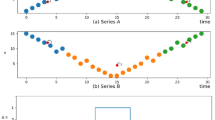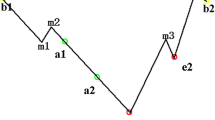Abstract
Anomaly detection is a challenging problem in science and engineering that appeals to numerous scholars. It is of great relevance to detect anomalies and analyze their potential implications. In this study, a multi-level anomaly detection framework with information granules of higher type and higher order is developed based on the principle of justifiable granularity and Fuzzy C-Means (FCM) clustering algorithm, including two different types of approaches, namely abstract level approach (ALA) and detailed level approach (DLA). The ALA approach is implemented at a comparatively abstract level (viz., level-1), in which two distinct types of information granules of order-1 (viz., information granules of type-1 and type-2) are employed for anomaly detection. The DLA approach is formulated and derived from the ALA approach at a more detailed level (viz., level-2), which generates more detailed information granules, namely information granules of order-2, through successive splitting information granules and the FCM clustering algorithm to refine the problem at various levels. Furthermore, a similarity measurement algorithm is designed for anomaly detection utilizing information granules of higher type and higher order. Comprehensive performance indexes are produced to quantify the performance of the proposed framework compared with the methods of two single-level approaches and two multi-level approaches. Synthetic data and several real-world data coming from various areas are engaged to demonstrate and support the superiority of the proposed approaches over other classical methods in terms of detection accuracy and data anomaly resolution.




















Similar content being viewed by others
References
Zhao F, Zeng G, Lu K (2019) EnLSTM-WPEO: short-term traffic flow prediction by ensemble LSTM , NNCT weight integration, and population extremal optimization. IEEE Trans Veh Technol 69(1):101–113
Chen M, Zeng G, Lu K (2019) A two-layer nonlinear combination method for short-term wind speed prediction based on ELM, ENN, and LSTM. IEEE Internet Things J 6(4):6997–7010
Li H, Boulanger P (2020) A survey of heart anomaly detection using ambulatory electrocardiogram (ECG). Sensors 20(5):1461
Kumar S, Toshniwal D (2016) A novel framework to analyze road accident time series data. J Big Data 3(1):1–11
Zhou Y, Ren H, Li Z, Pedrycz W (2021) Anomaly detection via a combination model in time series data. Appl Intell 51(7):4874–4887
Li J, Pedrycz W, Jamal I (2017) Multivariate time series anomaly detection: a framework of hidden Markov models. Appl Soft Comput 60:229–240
Habeeb RAA, Nasaruddin F, Gani A (2019) Real-time big data processing for anomaly detection: a survey. Int J Inf Manag 45:289–307
Blzquez-Garca A, Conde A, Mori U (2021) A review on outlier/anomaly detection in time series data. ACM Comput Surveys (CSUR) 54(3):1–33
Mishra K, Basu S, Maulik U (2022) Graft: a graph based time series data mining framework. Eng Appl Artif Intell 110:104695
Zhou Y, Ren H, Li Z, Pedrycz W (2021) An anomaly detection framework for time series data: an interval-based approach. Knowl-Based Syst 228:107153
Moeyersons J, Smets E, Morales J (2019) Artefact detection and quality assessment of ambulatory ECG signals. Comput Methods Programs Biomed 182:105050
Izakian H, Pedrycz W (2013) Anomaly detection in time series data using a fuzzy c-means clustering. 2013 Joint IFSA world congress and NAFIPS annual meeting (IFSA/NAFIPS) pp 1513–1518
Zhu X, Pedrycz W, Li Z (2016) Granular encoders and decoders: a study in processing information granules. IEEE Trans Fuzzy Syst 25(5):1115–1126
Pedrycz W, Lu W, Liu X (2014) Human-centric analysis and interpretation of time series: a perspective of granular computing. Soft Comput 18(12):2397–2411
Ren H, Liu M, Liao X (2018) Anomaly detection in time series based on interval sets. IEEJ Trans Electr Electron Eng 13(5):757–762
Ren H, Liu M, Li Z, Pedrycz W (2017) A piecewise aggregate pattern representation approach for anomaly detection in time series. Knowl-Based Syst 135:29–39
Jiang W, Hong Y, Zhou B (2019) A GAN-based anomaly detection approach for imbalanced industrial time series. IEEE Access 7:143608–143619
Ren H, Ye Z, Li Z (2017) Anomaly detection based on a dynamic Markov model. Inf Sci 411:52–65
He H, Tan Y (2017) Automatic pattern recognition of ECG signals using entropy-based adaptive dimensionality reduction and clustering. Appl Soft Comput 55:238–252
Howedi A, Lotfi A, Pourabdollah A (2020) A multi-scale fuzzy entropy measure for anomaly detection in activities of daily living. In: Proceedings of the 13th ACM international conference on PErvasive technologies related to assistive environments, pp 1–8
Huang L, Ran J, Wang W (2021) A multi-channel anomaly detection method with feature selection and multi-scale analysis. Comput Netw 185:107645
Chen X, Zhan Y (2008) Multi-scale anomaly detection algorithm based on infrequent pattern of time series. J Comput Appl Math 214(1):227–237
Zhu X, Pedrycz W, Li Z (2019) Development and analysis of neural networks realized in the presence of granular data. IEEE Trans Neural Netw Learn Syst 31(9):3606–3619
Zhang B, Pedrycz W, Wang X (2020) Design of interval type-2 information granules based on the principle of justifiable granularity. IEEE Trans Fuzzy Syst
Pedrycz W, Al-Hmouz R, Balamash AS (2015) Hierarchical granular clustering: an emergence of information granules of higher type and higher order. IEEE Trans Fuzzy Syst 23(6):2270–2283
Gacek A, Pedrycz W (2014) Clustering granular data and their characterization with information granules of higher type. IEEE Trans Fuzzy Syst 23(4):850–860
Liu S, Pedrycz W, Gacek A (2018) Development of information granules of higher type and their applications to granular models of time series. Eng Appl Artif Intell 71:60–72
Pedrycz W, Bargiela A (2011) An optimization of allocation of information granularity in the interpretation of data structures: toward granular fuzzy clustering. IEEE Trans Syst Man, and Cybern 42(3):582–590
Izakian H, Pedrycz W, Jamal I (2012) Clustering spatiotemporal data: an augmented fuzzy C-means. IEEE Trans Fuzzy Syst 21(5):855–868
Pedrycz W, Wang X (2015) Designing fuzzy sets with the use of the parametric principle of justifiable granularity. IEEE Trans Fuzzy Syst 24(2):489–496
Pedrycz W, Homenda W (2013) Building the fundamentals of granular computing: a principle of justifiable granularity. Appl Soft Comput 13(10):4209–4218
Wang D, Pedrycz W, Li Z (2018) Granular data aggregation: an adaptive principle of the justifiable granularity approach. IEEE Trans Cybern 49(2):417–426
Lu W, Chen X, Pedrycz W (2015) Using interval information granules to improve forecasting in fuzzy time series. Int J Approx Reason 57:1–18
Li J, Izakian H, Pedrycz W (2021) Clustering-based anomaly detection in multivariate time series data. Appl Soft Comput 100:106919
Keogh E, Lin J, Fu A (2005) Hot SAX: efficiently finding the most unusual time series subsequence. Fifth IEEE Int Conf Data Mining (ICDM’05)
Acknowledgements
This work was supported in part by the Fundamental Research Funds for the Central Universities under Grant K50510040013 and Grant K5051304007, in part by the Natural Science Foundation of China under Grant 61374068, and in part by the Science and Technology Development Fund, MSAR, under Grant 078/2015/A3, and the Doctoral Students Study Abroad Scholarship Fund of Xidian University.
Author information
Authors and Affiliations
Corresponding author
Additional information
Publisher’s note
Springer Nature remains neutral with regard to jurisdictional claims in published maps and institutional affiliations.
Rights and permissions
Springer Nature or its licensor holds exclusive rights to this article under a publishing agreement with the author(s) or other rightsholder(s); author self-archiving of the accepted manuscript version of this article is solely governed by the terms of such publishing agreement and applicable law.
About this article
Cite this article
Zhou, Y., Ren, H., Zhao, D. et al. A novel multi-level framework for anomaly detection in time series data. Appl Intell 53, 10009–10026 (2023). https://doi.org/10.1007/s10489-022-04016-y
Accepted:
Published:
Issue Date:
DOI: https://doi.org/10.1007/s10489-022-04016-y




